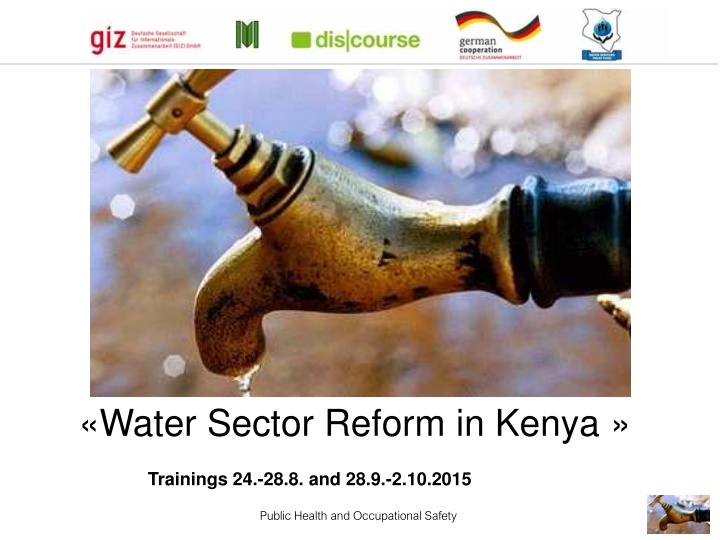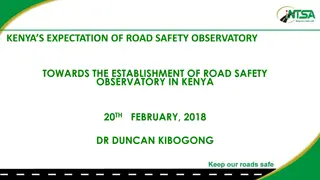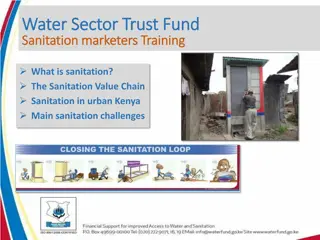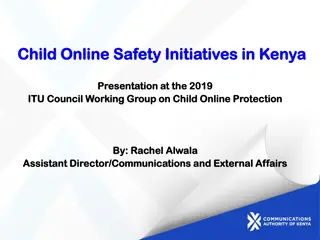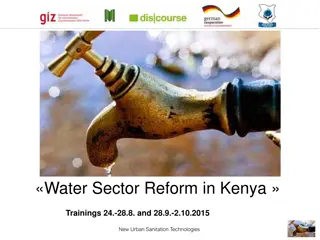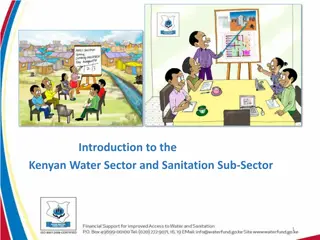Water Sector Reform & Public Health Safety Training in Kenya
Trainings on water sector reform in Kenya were conducted focusing on public health and occupational safety. The sessions covered topics such as self-protection, safety equipment, wastewater system operation, and hazards like electrical shocks. Participants learned about safety measures including safety shoes, gloves, helmets, reflective vests, gas masks, and more to protect against various risks in the workplace.
Download Presentation

Please find below an Image/Link to download the presentation.
The content on the website is provided AS IS for your information and personal use only. It may not be sold, licensed, or shared on other websites without obtaining consent from the author.If you encounter any issues during the download, it is possible that the publisher has removed the file from their server.
You are allowed to download the files provided on this website for personal or commercial use, subject to the condition that they are used lawfully. All files are the property of their respective owners.
The content on the website is provided AS IS for your information and personal use only. It may not be sold, licensed, or shared on other websites without obtaining consent from the author.
E N D
Presentation Transcript
Water Sector Reform in Kenya Trainings 24.-28.8. and 28.9.-2.10.2015 Public Health and Occupational Safety
Public Health and Occupational Safety Based on DWA/Engicon Introduction to Wastewater & Health & Safety , modified by Margraf Publishers Public Health and Occupational Safety
Table of Content Self protection & safety equipment Wastewater System Operator Work in Manholes Safety harness Public Health and Occupational Safety
Self protection & safety equipment: Safety shoes Safety shoes to protect the employee foot from cold, wet or falling of heavy weight things and from sliding.. Gloves Gloves If there are injury risks or contagious diseases in the handwork. Helmet Helmet to absorb shock on the head under any circumstances. Reflective vest Reflective vest to indicate the employee on roads and nearby roads or in cloudy or rainy atmosphere and in areas with low efficient lighting. Gas mask Gas mask: in confine spaces A respirator prevents you from inhaling any germs in the air Public Health and Occupational Safety
Self protection & safety equipment Long sleeve safety boot Long sleeve safety boot to protect the foot from wet and cold. And to protect the foot from contagious diseases available in the wastewater and contaminated water. Raincoat Raincoat to protect the employee from wet under rain or snow and facilitate his work in such weather. Lab coat Lab coat to protect the body and clothes of the employee when dealing with chemicals. Earmuffs Earmuffs to protect the hearing level of the employee from extreme sounds. Public Health and Occupational Safety
Self protection & safety equipment Electricity Electricity- -resistance equipment resistance equipment to protect the employee from the risks of electrical shocks. Goggles Goggles to protect the eyes of the employee from dust or dispersed particles. Face Face- -shield shield to protect the employee eyes from welding ray and heat. Public Health and Occupational Safety
Wastewater System Operator Operating wastewater networks is considered a job with special responsibilities which is full of challenges. The operator is required to have specific qualifications the average knowledge in many aspects, good common sense that guides in decision making in different conditions and circumstances, and shall be a highly trained and skilled professional. specific qualifications such as above The safety of the operator s life is related to the operator s experience and that is manifested in his/ her commitment to safely completing every task. Public Health and Occupational Safety
WW System Operator Protection Protective procedures include the followings: Protect yourself from getting infected by wearing the suitable clothes like gloves, chemical resistant clothing, Helmet, and safety boots. Use creams to prevent your skin against organics that cause diseases. They also reduce dermatitis effects. Use the first aid kit immediately- clean the effected area then use a disinfectant. Use a waterproof bandage. Public Health and Occupational Safety
First Aid Kit A first aid kit shall always be ready and handy to operators at the manholes to be used right away. At least one person in the team (more than one person is preferable) shall be trained on using the first aid kit and perform first aid trained on using the first aid kit and perform first aid procedures. procedures. Public Health and Occupational Safety
The WW System operators health state The operator entering the manhole shall follow the following rules before entering: Shall be in a good health state Be in a good physical condition Free from hangover or medication related side effects. You shall not have any open wounds or blisters. Shall have the up-to-date vaccinations vaccinations required. Public Health and Occupational Safety
Work in Manholes Entering manholes is considered a very dangerous task: It has the potential for exposure to dangerous and flammable chemicals and gases. It can also expose the workers to injuries, contagious diseases and insects. However, the work in manholes can be safe if proper measures are being followed. Public Health and Occupational Safety
Expected Risks in Manholes There following are the major hazards that face the operator in manholes: physically injuries (slipping & falling construction failure, falling objects), infectious disease, insects and creatures that sting, exposure to toxicants, drowning Public Health and Occupational Safety
Safety harness with lifeline tripod and winch Any person entering the manhole or a confined space is required to wear the safety harness safety harness. The safety harness and lifeline can be used to lower the person down to the confined space. Any network operator stays up while the other worker is under the ground (in the manhole) and that is to monitor the safety harness s performance. A third person shall be near them, for it is required to have two people to lift up an unconscious worker outside of the manhole. Public Health and Occupational Safety
Ropes and Buckets Ropes and buckets are used to lower the tools into the manholes and lifting them up again. The safety clasp prevents the bucket from swinging. The dropping of tools and throwing them back up outside of the manhole had caused many injuries in the past. Public Health and Occupational Safety
Entering a manhole procedures (I) Minimum staff is 3 persons. Place a safety loop around the manhole if necessary. Adjust the portable gas detector portable gas detector before moving the manhole s cover. Examine the entire depth of the manhole starting from its bottom to surface to determine the toxicants, flammable and explosive gases (H2S) and the shortage of Oxygen. Check if there is any combustible mixture before removing the manhole s cover if possible. Removing the manhole s cover might produce a spark that can cause an explosion. This action is good also in knowing the ventilation conditions down the manhole. Public Health and Occupational Safety
Entering a manhole procedures (II) Never use your hands to remove or return the manhole s cover; use any approved winch. Open the manhole from the top and bottom of the work site and that is to create a natural circulation in the manhole. Cover the manhole with grating and place barriers around the manhole to warn pedestrians and traffic. Sweep the area before removing the manhole s cover, and clean Public Health and Occupational Safety
Entering a manhole procedures (III) The network operator ready to enter the manhole shall ensure that he had fastened the safety harness and lifeline correctly. The other workers or supervisor shall ensure that the safety protection clothing and equipment are safe and tied properly. It is necessary to continuously monitor the air atmosphere continuously monitor the air atmosphere at the manhole during the presence of the network operator, to examine the shortage, enrichment of the Oxygen, flammable and explosive toxicant gases. Public Health and Occupational Safety
While the operator in the manhole Lifeline end shall be secured outside the confined space. Oxygen shortage shall be examined continuously as long as the network operator is in the manhole, examining toxicant flammable and explosive gases (H2S). Good ventilation prevents problems from happening inside the manhole. Public Health and Occupational Safety
While the operator in the manhole A team worker present at the safety enclosure shall continuously monitor the network operator in the manhole and perform no other activities. He should be attentive and secure everything in his pockets against falling down accidentally and injuring the network operator. The assistant shall always be ready for any call for help. The network operator shall be pulled out of the manhole if any problem indications start to appear like irregular drainage, alerts from the atmosphere controller. Public Health and Occupational Safety
Post Exiting the Manhole At the end of the working day, the worker who was present in the manhole shall take a shower and wear clean clothes before leaving work, for clothes worn in the manhole shall not be reused under any circumstances. Don t expose your family to the risk of contagious diseases should they touch that clothing. Don t wear any clothing that had been worn during wastewater network/home maintenance. Don t wash these clothing in your private washing maschine and keep the work uniform and the office uniform in separate closets. Public Health and Occupational Safety
